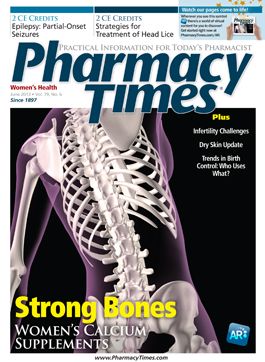Clinical Implications in Women's Health
Pregnancy, oral contraceptive use, and hormone therapy can increase risk of thromboembolism.

Pregnancy, oral contraceptive use, and hormone therapy can increase risk of thromboembolism.
Heart disease, stroke, and cancer are the top-ranking health concerns for women. The risk of thrombosis often exists concurrently alongside these conditions. During various stages in a woman’s life, the risk of thromboembolism rises. Pregnancy, the use of oral contraceptives, and postmenopausal hormone therapy can further increase the risk of venous thromboembolism. Additionally, factor in 1 or more of the additive risk factors of age, genetic predisposition, obesity, smoking, immobility, trauma/surgery, and cancer, and the risk can increase as high as 20-fold!1
These concerns are to be addressed by women of all ages. In fact, you may have met her in your pharmacy.
- The 24-year-old woman who comes into your store to pick up her birth control prescription. Her past medical history is pertinent for Factor V Leiden (heterozygous), her mother has a history of phospholipid antibody syndrome, and her most recent physical exam was unremarkable.
- The 56-year-old woman experiencing hot flashes and vaginal dryness who arrives to pick up her prescription for estrogen. Her past medical history reveals a BMI of 50, while her family history reveals that her sister has experienced deep vein thrombosis while taking birth control. Her most recent physical exam describes a normal mammogram and normal bone density.
Hormone Therapy Risks
The Women’s Health Initiative (WHI) trial described that the risk of venous thromboembolism doubled among women assigned to the estrogen plus progestin group. It also displayed the risk associated with hormone therapy and advancing age compared with hormone therapy and obesity as being higher, with an annual risk of 0.2% and 0.5%, respectively. The WHI also reinforced the finding that Factor V Leiden in the presence of estrogen use further increases the risk of thrombosis as much as 2.6-fold in heterozygotes and 7.5-fold in homozygotes. For women taking birth control with none of the aforementioned risk factors or thrombophilias, the risk for developing a blood clot may be less than 0.5% over 5 years.1
Upon addressing the risks versus benefits of hormone replacement therapy, the question is which (if any) therapies should be utilized? Is there benefit to using lower doses of the estrogen-plus-progestin combination? Is progestin only a better option? Are the nonoral options better alternatives?
Estrogen Benefits
There is limited information; however, lower doses of estrogen might be beneficial. Third-generation progestins, such as desogestrel or gestodene, may bear an increased risk of clotting versus second-generation levonorgestrel. In April 2012, the FDA released an advisory upon completing a review of observational studies regarding the risk of blood clots in women taking drospirenone-containing birth control pills. It was determined that the risk was 2-fold higher than with the second- and third-generation progestin products.
In terms of progestin-only pills or the “mini pill,” small-scale studies have indicated that Micronor (norethindrone) and Loestrin (desogestrel) have no increased risk alone, while the latter may act synergistically with estrogen to intensify estrogen-related side effects.2 The nonoral route is not without its share of reported events. There are case reports of thrombosis with the NuvaRing (etonogestrel/ethinyl estradiol) and a 3.6-fold heightened risk with Depo Provera (medroxyprogesterone acetate).3,4
In 2005, the FDA updated the labeling for the Ortho Evra (norelgestromin/ethinyl estradiol) transdermal patch to warn health care providers that the risk of blood clots may be higher secondary to higher levels of estrogen versus most birth control pills.5-7 Intrauterine copper contraceptives such as ParaGard have not been shown to increase the risk of clotting significantly thus far.
It is important to discuss and gain an understanding of a patient’s individual risks, benefits, and most appropriate options for care, as there are differences among the available options. One would be best advised to seek out assistance from a gynecologist and collaborate with a thrombosis specialist, as the clinical implications can be vast.
Ronelle E. Stevens, PharmD, RPh, CACP, is an advanced practice anticoagulation pharmacist for the Partners Healthcare System and an adjunct clinical assistant professor of pharmacy at Northeastern University’s Bouvé College of Health Sciences in Boston, Massachusetts. This column’s information is based on current studies and references, but it may be updated without notice with newer studies or with different populations.
References:
- Cushman M, Kuller L, Prentice R, et al. Estrogen plus progestin and risk of venous thrombosis. JAMA. 2004;292:1573-1580.
- Lidegaard Ø, Løkkegaard E, Svendsen AL, et al. Hormonal contraception and risk of venous thromboembolism: national follow-up study. BMJ. 2009;339:b2890.
- Fleischer K, van Vliet HA, Rosendaal FR, et al. Effects of the contraceptive patch, the vaginal ring and an oral contraceptive on APC resistance and SHBG: a cross-over study. Thromb Res. 2009;123(3):429-435.
- Van Hylckama Vlieg A, Helmerhorst FM, Rosendaal FR. The risk of deep venous thrombosis associated with injectable depot-medroxyprogesterone acetate contraceptives or a levonorgestrel intrauterine device. Arterioscler Thromb Vasc Biol. 2010;30:2297-2300.
- Johnson JV, Lowell J, Badger GJ, et al. Effects of oral and transdermal hormonal contraception on vascular risk markers: a randomized controlled trial. Obstet Gynecol. 2008;111:278-284.
- Dore DD, Norman H, Loughlin J, et al. Extended case-control study results on thromboembolic outcomes among transdermal contraceptive users. Contraception. 2010;81(5):408-413.
- Jick SS, Hagberg KW, Hernandez RK, et al. Postmarketing study of ORTHO EVRA and levonorgestrel oral contraceptives containing hormonal contraceptives with 30 mcg of ethinyl estradiol in relation to nonfatal venous thromboembolism. Contraception. 2010;81(1):16-21.

